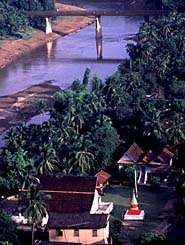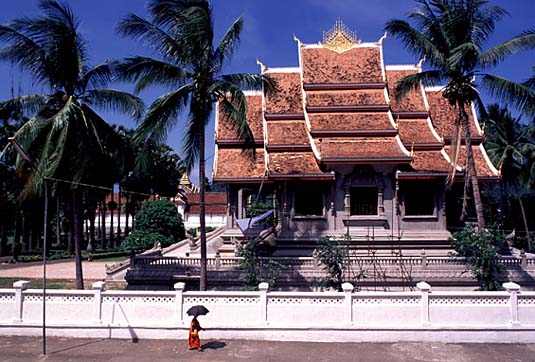World Wonder in the Jungle
Landlocked and isolated from the eyes of the world, Laos has always been easy to overlook, but now a trickle of tourists are arriving in the ancient capital, where they are blown away by the temples and mellow pace of Luang Prabang, on the banks of the Mekong
By Ron Gluckman /Luang Prabang
T
HE ENGINE COUGHS, THEN WHINES like a wild animal. As the plane drops down towards the murky Mekong River, golden flashes pulse from the dense jungle below. They look like ancient treasures, which they are. The pulses of light are reflections, coming from gilded pagodas poking through the foliage of a spectacular tropical Shangri-la. Scores of Buddhist temples are
tucked amongst towering palms lining the shores of a lush peninsula, where the Mekong
River meets the Nam Khan River. It was here, in 1353, that King Fa Ngum founded Lan Xang,
the empire of a million elephants.
Scores of Buddhist temples are
tucked amongst towering palms lining the shores of a lush peninsula, where the Mekong
River meets the Nam Khan River. It was here, in 1353, that King Fa Ngum founded Lan Xang,
the empire of a million elephants.
The history of Laos is filled with turbulence and tragedy, but 367 kilometres northwest of the modern capital of Vientiane, sits a pristine reminder of all that prompted early explorers to dub Indochine as Asia’s mystical paradise.
In those days, during French rule, Luang Prabang was a rough one week journey up river from Vientiane. As recently as a few years ago, the main route to this remote Mekong village was a muddy track that sometimes took days to traverse.
Nowadays, reaching this rediscovered world wonder involves a mere 40 minute-flight from civilization - meaning the Laotian capital of Vientiane. The lifting of strict visa restrictions two years ago puts Luang Prabang within reach of nearly any tourists. Suddenly, this serene Mekong outpost has been thrust into the mainstream.
Yet, in its first full summer season, the ancient capital of Laos is faring rather well as the latest in-vogue, off-the-track tourist attraction. So far, the footprints of tourists haven’t even kicked a cloud of dust over the luster of Luang Prabang.
The temples aren’t nearly as old as the Great Pyramid of Egypt, as massive as Cambodia’s Angkor Wat, or as numerous as those spreading across the great Bagan plain in Burma. Yet Luang Prabang’s appeal is its unsurpassed jungle setting, and the feeling that the people have lived here for ages, unaffected by time.
"It’s like Thailand thirty years ago," says one American visitor. "Or Vietnam, without the hustle and hassles."
Indeed, Laos is a throwback to another era. When the communists took over after a bitter civil war in the 1970s, they closed the doors to Laos. With the shutters open, visitors are discovering a mesmerizing showpiece from a quarter of a century ago.
Nowhere is the product of this self-imposed isolation more stunning than in Luang Prabang, where dazzling 16th century Buddhist temples stand beside 19th century colonial French villas, while water buffalo work surrounding rice fields. Visitors can sip coffee on hotel patios, or rent bicycles and pedal down Luang Prabang’s main street at mid-day, without ever worrying about encountering a car.
Phou Si, a hill in the centre of this city of 25,000 people, is the best place to start a tour. A golden stuppah shines enticingly through the trees on the hilltop; numerous other shrines can be found along the way. There are two main paths, so visitors can take a different route in each direction. The best time to visit is just before sunset, when the entire delta radiates a rich golden glow.
Buddhism was severely repressed for decades in Laos, but fortunately, the destruction visited upon other religious sites in the region seems to have spared Luang Prabang. Likewise the ravages of the great American conflict in Southeast Asia, when more bombs were dropped on Laos than during all of World War II. The town’s abundant temples, although left in neglect for decades, have survived and sat waiting, it seems, for the current spurt of restoration.
 Listing
them all would require volumes. The best way to explore is by bicycle, in a leisurely
pattern. Walking is also convenient, since many of the major temples are in central Luang
Prabang. But bikes take you over the bridges to scenic sites scattered across the other
side of the Mekong and Nam Khan.
Listing
them all would require volumes. The best way to explore is by bicycle, in a leisurely
pattern. Walking is also convenient, since many of the major temples are in central Luang
Prabang. But bikes take you over the bridges to scenic sites scattered across the other
side of the Mekong and Nam Khan.
Wat Xieng Thong is among Luang Prabang’s more prominent Temples. Founded by King Setthathirat in 1560 on a rise overlooking the confluence of the two rivers, it offers a commanding view of the countryside. A staircase guarded by lion statues leads up from the Mekong River.
The buildings showcase various styles of Laotian religious architecture, as well as the distinctive black and gold story figures, more intricate than found anywhere else in the Buddhist realm, and bright, multi-coloured mosaics. There is also a huge elephant head among the statues scattered around the landscaped grounds. Of special note is an enormous dragon float. This was actually the funeral bier built in 1961 for the burial of King Sisavan Vong, who used to watch river boat processions from this spot.
Other mandatory stops include Wat Mai, meaning "new monastery" - it’s only a century old, which displays the beautiful local style of five-tiered roofs, and Wat Sene, which has some of the classiest architecture. Both are open for prayer and the enchanting evening chanting sessions are highly recommended.
A bit off the beaten track is Wat Paphonphao, an unusual octagonal temple on a hill a long way outside Luang Prabang. However, its golden dome is visible for miles. The two-story building has many hidden stairways and a bizarre collection of religious art. Many of the murals depict demons, burning bodies and other scenes of torture. In the visitor log, one guest has written: "Wow, cool hell scenes."
Fortunately, most of Luang Prabang’s functioning temples are more conventional, but the years of isolation and religious repression have left a severe shortage of monks. Young novices are flocking back to temples only to find a lack of qualified teachers. The result is a motley crew of disciples, some smoking and many with tattoos. On the positive side, they display a playful optimism and eagerness to move forward.
That, without a doubt, is the mood of the entire nation, and the entrepreneurial spirit is strong in Luang Prabang. During the past two years, a number of boutique hotels have opened to offer upscale options to the traditional upcountry guesthouse.
The best of these include the Villa Princess, a charming boutique lodge that was once part of the royal residence, and the dazzling L’Hotel Souvanaphoum, a stunning colonial mansion replete with white marble and white wicker furniture. Both offer intriguing blends of regional and French cuisine in lovely dining rooms.
Yet even in the old communist party lodges, service standards are surprisingly solid, at bargain prices. There is also a delightful old world charm about places like the Pousy Hotel, with its antique rattan furnishings and French-speaking clerk.
Planning a schedule in Luang Prabang is simple, since there is no shopping or nightlife. Some silversmiths can be found, but aside from a few small furniture shops, the tourist trade has thus far left Luang Prabang refreshingly free of trinket stands.
The Royal Palace recently reopened, and it’s worth a look to see some of the treasures of the former royal family. But the hours have been irregular and only a small portion of the palace is open to the public, pending renovation.
Day trips in the surrounding area include visits to the ethnic minority people, which include the Xayabouri and Houayxay. However, these trips take some time and should be carefully planned well in advance.
There is a waterfall at Khouang Si, about 25 kilometres south of town, a 90-minute drive by hired tuk-tuk. (Luang Prabang has no public transportation except for a few tuk-tuks that run between town and the airport.) The waterfall is worth the price of the hire since it offers an opportunity to visit several villages on the way. Waterwheels and hand-made tools are the norm here, and the people win over guests with a manner that recalls an earlier age in Asia, when visitors were rarer, and welcomes were warmer.
There are boat trips to the Pak Ou caves, about 30 kilometres up the Mekong River. Visitors climb a set of steep steps to the caves, where hundreds of figures of Buddha have been placed by local villagers.
A more exhilarating Mekong River run comes in native longboats, equipped with powerful motors, which jet up river from Luang Prabang to Ban Houei Sai, where you can cross into Thailand. The frightfully noisy trip takes nine hours and costs US$25. Be warned: it’s amazing fun roaring past the scenery, but only for the first hour. The thin boats are also quite uncomfortable for anyone of western proportions.
Aside from such adventures, Luang Prabang is really the perfect place to relax, read a book, or write one. The main appeal is to merely unwind.
Visitors will also relish the town’s architectural treasures. French architect Francois Greck, who has been visiting since 1989, has catalogued scores of historical structures. "The most important historical area is along the Mekong River," he says. "This includes a lot of old French homes, many temples and other buildings."
Even through the 1900s, construction at Luang Prabang was unique, utilizing native materials in a variety of designs heavily influenced by local conditions. The result is a hodge-podge of French tropical, Laotian and religious architecture.
"What is important is that this is the historical architecture of the place, distinctive to this river and the flavour of Luang Prabang," he says. "It must be preserved."
And soon it should be. Greck is among those advocating World Heritage Site status for the town. The designation through the United Nations would both protect the historical sites and make available funding for their preservation. An application has already been prepared and the prognosis looks good, according to Greck.
In the meantime, the modern world wonder, locked away for decades, is back on display. "And it should remain like this," Greck says, "for all people to enjoy. Forever."
Ron Gluckman is an American journalist based in Hong Kong, who roams widely around the Asian region for numerous publications, including Asia Magazine, which ran this story in September 1996. Laos is one of his favorite countries.
To return to the opening page and index
push here
[right.htm]
